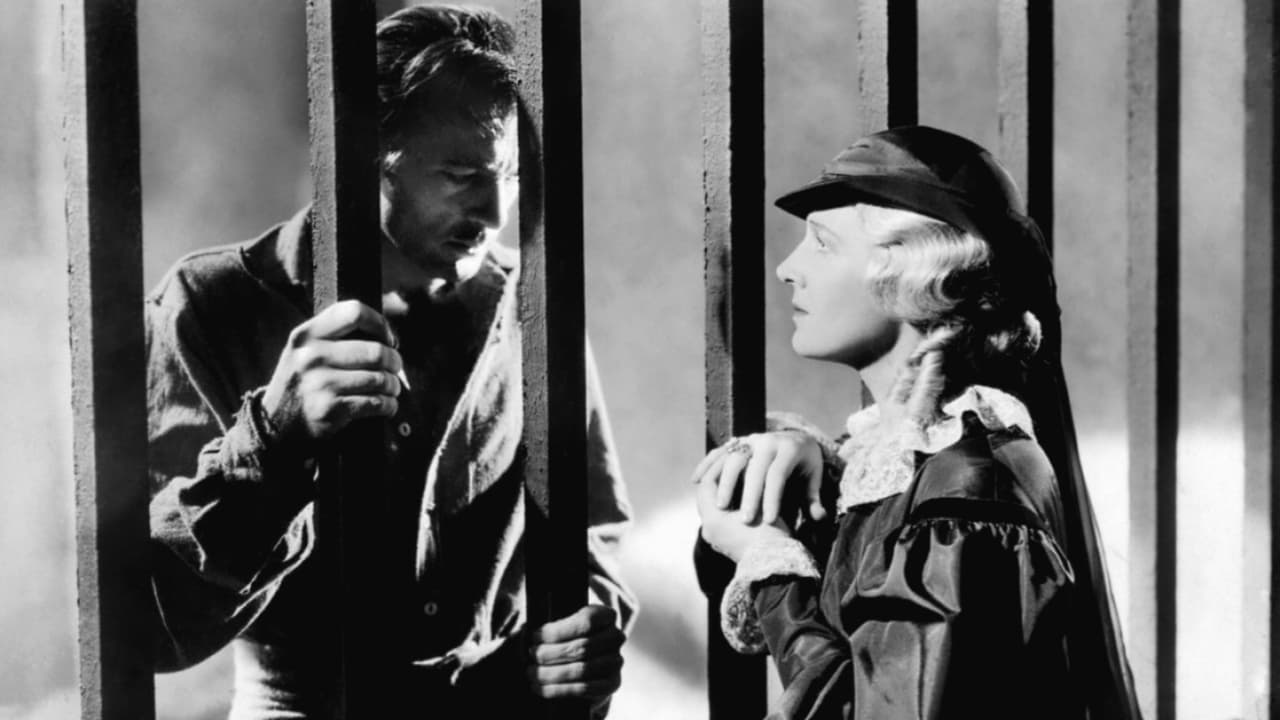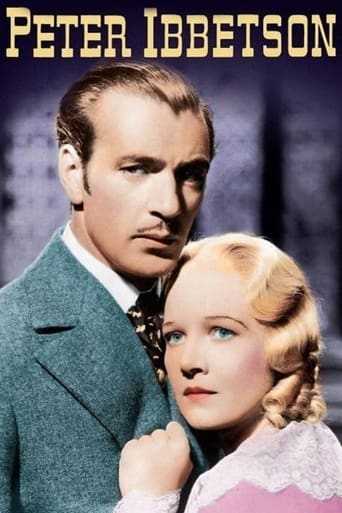

In the abstract,"Peter Ibbetson" is a lovely idea. It's quite another matter in practical terms. It gets off to a good start with the principals as children - in fact, the child actors are better than the adult versions, which is one of my main objections to the film. I am a fan of Gary Cooper despite his limitations as an actor. He's great in action pictures - the strong, silent type with a minimum of expression and dialogue. But he's in over his head as the title character and just lacks the required acting range. There are scenes in which a better actor would register the nuance and facial expression necessary, but Coop registers... not much, I'm afraid. Ann Harding is pretty in a dowdy, fat-faced sort of way but is simply not good enough for the part.Having said that, the picture has a lovely score and the pacing is brisk. Director Hathaway had a long and distinguished career in Hollywood and does his darndest here but is hamstrung by my second objection, the last half of the story, which is, ah, a challenge. I can appreciate fantasy but, ladies and gentlemen, this is over-the-top fantasy and I know when I'm being taken for a ride.I tried, Lord knows, I tried to go with it, but give me a break. I found the first half of the picture hauntingly beautiful ,as a professional movie reviewer might say. And I am as romantic as the next guy. I found the scene in which they re-connected after so many years very touching. I found the scenes between their parting as children even more so. But not the 'dream' scenes as adults - those were far-fetched, and let's leave it at that.There is a question that comes with our reviews on the website that asks, "Did you find this review useful?". This review IS useful, even if you don't agree with it. I just think that there is a fine line between romanticism and goofiness.
... View MoreWhile it's obvious that almost all the reviewers adored this film, I feel a voice of dissent is needed, as I have a different perspective. Although this is one of the loveliest looking films I can think of from the era, I was left cold by the film because I felt the plot didn't make much sense and because the characters were jerks---yes, jerks. To me, the film was NOT about true romance but blind infatuation and selfishness, but more about that later.The film begins with a prologue. Young Peter Ibbetson (played by Dickie Moore) looks to be about 5 and he is alternately playing with and arguing with the little girl who is his best friend. Unfortunately, soon his mother dies and he is taken to England to live out most of the rest of his life. However, the plot demands that this little infatuation with a little girl is not only NOT forgotten but so consumes Ibbetson that decades later he returns to France to try to find this girl. This is utterly ridiculous, as was his "accidentally" discovering this same girl, now grown, quite by mistake when he fell in love with her all over again (while not realizing it was the same person). Talk about straining credibility! But, it gets worse. The lady is already married--yet Ibbetson doesn't give a darn about the husband and demands that she run off with him!!!!!! So, they're basing this "love that will withstand the ages" mostly on the vague recollections of a guy thinking about life at age 5...and this doesn't seem illogical to anyone? Plus, now the lady is married to a wealthy titled man and yet this will somehow work out?!! When the husband finds out and tries to kill Ibettson (after all, this is a matter of honor and it is the early 19th century--a duel or simply shooting Ibbetson would have been the proper tactic), the husband is killed in the scuffle...and we are expected to feel bad only for Ibbetson and his lady love? I actually felt worse for the husband--up until then, he seemed like a decent enough sort. Sure, he shouldn't have tried to kill Peter, but can you blame him for trying to get rid of this shameless home-wrecker? Now, Ibbetson is in prison for the rest of his life. Now here it gets weird...very weird. Ibbetson spends the rest of his life meeting with and loving Mary in his mind--and she, too, can see and experience all these meetings along with him! There is no explanation for this odd symbiosis...it just happens as if by magic. And, when he finally dies, they meet in some external bliss together. Uggh--what hooey! These portions of the film are so sticky and tough to watch.So, the film is based on a love affair between two dumb and selfish people. Dumb, because loving somebody as a small child should NOT be the basis for uprooting and destroying lives. This movie is all emotion and no logic from start to finish. Cooper plays a selfish and mushy character who I had a hard time liking--not a rugged or manly sort of fellow, just a jerk.So why did I still give the movie a 4 even if I though I disliked the plot so much and felt it tried to justify adultery? Well, I gotta hand it to Henry Hathaway's direction--it was a truly lovely film to look at and it was very manipulative. Plus, the great sound track really pulled on your heartstrings (whatever a 'heartstring' is).
... View MoreI imagine this is exactly the sort of film that if you saw it at an impressionable age in your youth, it would make a lasting impression on you for the rest of your life. As I am not old enough to have been young when the film came out I cannot vouch for this. Nevertheless, I have possessed this film for several years on VHS and generally view it every 24 months or so. Picture and sound quality are below par as to be expected for a film of this age. I see that a DVD is now available but only as part of a boxed set and I don't fancy the idea of having to purchase a whose set, just to obtain one DVD !! With repeated viewings I have grown to like the film more. I originally only liked the first half and thought the second half to be a little boring but now I find that it is more watcheable. The thing is, there are unfortunately very few of this type of film made, the one that immediately comes to mind is of course Portrait of Jennie which had much better picture and sound quality and moved me emotionally far more than Peter Ibbetson. That said, the film has good points but I find the "grown-up" passion to be not as strong as I would have hoped, given the fusion and complicity between the kids during the first half hour. The separation of the children is an extremely painful moment to watch .. we then jump forward in time and when they meet up again and find out who they are and what they mean to each other, I just couldn't feel as much emotion as I would have liked. This may due to the actors involved .. I did not know the lady actress and have appreciated Gary Cooper in cowboy rôles but not in the role of an architect though I seem to remember having seen him in a similar rôle in a film called the Fountainhead. I also found that his person was well suited to the role of Mr Deeds but here something seemed to be missing, without my being able to put a finger on precisely what. Still the film has good moments with the dream meetings in paradisiac places and the end of course is satisfying. The music score is also very emotional and I hope that in the future both sound and picture quality can be cleaned up. I hope this film is not remade as any remake today is bound to overdo the special FX side and all the charm will be lost. The film is therefore quite original in its style and is bound to appeal to those who like a dose of surrealism and escapism without necessarily being completely removed from reality.
... View MoreSometimes you watch a film which is so good that you wonder why it isn't better known. Peter Ibbetson is such a film. It takes a concept which is highly original but undoubtedly 'out there' and makes you believe in it for just under an hour and a half. It also manages to be a truly moving love story whose basic concept,a man and a woman who are apart for most of their lives meet in their dreams,and it's message,that love does indeed conquer all, should warm the hearts {and shed the tears}of die hard romantics everywhere.It's a bit stilted as many 30s films are,especially at first,but Charles Lang's expressionistic photography immediately creates a fairy tale feeling. The growing love between the young boy and girl is extremely touching. When they meet again as adults,it seems like the film is going to settle down into being a conventional love triangle tale {she's married}. Then the film suddenly changes,and although separated the two lovers carry out their relationship in their dreams. The film is quite subtle is depicting the dream world,although there are wonderful touches,such as the fairy tale castle that she creates with her imagination,only for it to crumble when he fails to believe in it. As for the ending,well,you would have to be very strong not to shed a tear. Like much of the film,it's almost underplayed,and is all the more moving for not being over the top.Gary Cooper shows once again what a great actor he was in his early days {as in A Farewell To Arms},really making us feel his character's pain and joy,although Ann Harding is perhaps a bit too earthy for her role. Director Henry Hathaway was generally a solid craftsman,but here he shows real engagement in his story.A great deal of attention is paid to set design,look at the way for instance the pair are often separated by bars of some sort in the 'real'world. Also notable is the music score by Ernest Toch,suitably romantic,but quite low key and sparse-Max Steiner would have plastered the film with music,but would it have really been as effective?Peter Ibbetson is a wonderful movie, and deserves to be ranked with some of the more better known fantasy romances of Hollywood's Golden Age. I'd actually like to see a remake of this,as it's such an amazing idea. But before that let's have a DVD release,please!
... View More